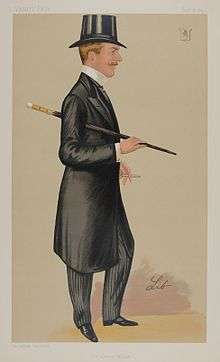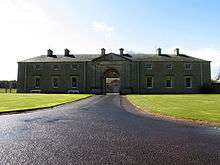Sir James Percy Miller, 2nd Baronet
Sir James Percy Miller, 2nd Baronet, DSO (22 October 1864 – 22 January 1906) was a British soldier, known as a racehorse owner. Over the 17 years when he had horses in training, Miller won 161 races, worth £114,005.[1]

Life
Miller was the eldest surviving son of Sir William Miller, 1st Baronet, by Mary Anne, daughter of John Farley Leith, a Queen's Counsel and Member of Parliament for Aberdeen. He was educated at Eton College and Sandhurst.[2][3][4]
Miller was a Captain in the 14th Hussars from 1885 to 1892, and Adjutant from 1888 to 1892; and served in the Second Boer War from 1900 where in 1901 he was second in command of the sixth battalion, Imperial Yeomanry. He was made an Hon. Major in the army in 1901 and became a full Major in the Lothians and Berwickshire Imperial Yeomanry from March 1902.[5] He was mentioned in dispatches, and was awarded the Distinguished Service Order.[1]

Miller was a Deputy Lieutenant and Justice of the Peace for Berwickshire.[1] His father's fortune, made from herring, allowed Miller to commission the complete rebuild of Manderston House as a stately home, near Duns, Berwickshire.[6] His town residence was 45 Grosvenor Square, Belgravia, London.
On 22 January 1906, Miller died at Manderston. His remains were interred at Christ Church, Duns.[1]
On the turf
In 1889 Miller, who had previously owned steeplechasers, became an owner of Thoroughbred racehorses.[1] In May 1890, he bought a racehorse called Sainfoin. Less than a month later, the horse won The Derby.[7] The purchase was from Sir Robert Jardine and John Porter; Sainfoin had won the Esher Stakes at Sandown Park easily. The price was £6000, plus half the value of the Derby, if the horse won. Sainfoin came in first, ahead of Le Noir, Orwell, and Surefoot.[1]
.jpg)
Miller's next stroke was the purchase in 1894 for 4100 guineas, as a yearling, of the mare Roquebrune (foaled in 1893), by St. Simon, who had been bred by the Duchess of Montrose. With Roquebrune he won the New Stakes at Ascot and the Zetland Stakes at Doncaster. Mated in 1899 with Sainfoin, Roquebrune produced Rock Sand, her first foal. With this colt Miller won in 1902 the Woodcote Stakes at Epsom, the Coventry Stakes at Ascot, the Champagne Stakes at Doncaster, and the Dewhurst Plate at Newmarket. In the following year Rock Sand won the Two Thousand Guineas, Derby, and St. Leger. During the three seasons he was in training, the horse won stakes to the value of £45,618, and helped place Miller at the head of the list of winning owners in 1903 and 1904, with totals of £24,768 and £27,928 respectively.[1]
In 1895 Miller won the Oaks with La Sagesse, a daughter of Wisdom, and in 1901 his filly Aida, by Galopin, won the One Thousand Guineas. His major success in handicaps was the victory in the Cesarewitch of 1898 with Chaleureux, the sire of the filly Signorinetta, who in 1908 won the Derby and Oaks for Edoardo Ginistrelli.[1]
Miller established a breeding farm at Hamilton Stud, Newmarket, where Rock Sand was foaled. He was elected a member of the Jockey Club in 1903, and became a steward of the Club. In December 1905 he sold by auction most of his mares, and Roquebrune was purchased by a Belgian breeder for 4500 guineas. Rock Sand was sold, after Miller's death, to August Belmont, Jr., for £26,000.[1]
Family
Miller married, 19 January 1893, Eveline (1864–1934) daughter of Alfred Nathaniel Holden Curzon, 4th Baron Scarsdale (1831–1916) by his spouse Blanche (1837–1875), daughter of Joseph Pocklington Senhouse, of Netherhall. They had no issue, and he was succeeded by his brother John Alexander Miller.[2][3]
Notes
- Stephen, Leslie, ed. (1885). . Dictionary of National Biography. 2. London: Smith, Elder & Co.
- Huggins, M. J. "Miller, Sir James Percy". Oxford Dictionary of National Biography (online ed.). Oxford University Press. doi:10.1093/ref:odnb/35023. (Subscription or UK public library membership required.)
- Who Was Who. Adam & Charles Black. 1929. p. 256.
- Thompstone, Stuart. "Miller, Sir William". Oxford Dictionary of National Biography (online ed.). Oxford University Press. doi:10.1093/ref:odnb/54385. (Subscription or UK public library membership required.)
- "No. 27422". The London Gazette. 4 April 1902. p. 2282.
- Christopher Unsworth (23 August 2013). The British Herring Industry: The Steam Drifter Years 1900-1960. Amberley Publishing Limited. p. 55. ISBN 978-1-4456-2416-7.
- "ENGLISH RACING ITEMS". Auckland Star. 30 July 1890. Retrieved 7 December 2011.
| Baronetage of the United Kingdom | ||
|---|---|---|
| Preceded by William Miller |
Baronet (of Manderston, Berwickshire) 1874–1887 |
Succeeded by John Alexander Miller |
- Attribution
![]()